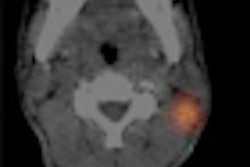FDG-PET imaging after two cycles of chemotherapy with doxorubicin, bleomycin, vinblastine, and dacarbazine (ABVD) is an "accurate and independent predictor" of event-free survival in patients with Hodgkin's lymphoma, according to a study published in the September issue of the Journal of Nuclear Medicine.
In addition, the researchers from Brazil found that a negative interim FDG-PET result can predict treatment success in overall Hodgkin's lymphoma patients and among patients with early- or advanced-stage disease. The lead author of the study was Juliano Cerci, MD, from the department of nuclear medicine at the University of São Paulo Medical School (JNM, September 2010, Vol. 51:9, pp. 1337-1343).
Hodgkin's lymphoma responds to standard chemotherapy, radiation therapy, or a combination of the therapies, with long-term cure rates of more than 80% in patients receiving the standard treatment. However, toxic effects such as myelosuppression, cardiac damage, and neuropathy can occur with treatment, along with radiation therapy side effects such as mucositis and xerostomia, according to the authors.
The ultimate goal, they noted, is to minimize such side effects without reducing the effectiveness of treatment, with treatment customized for the patient. It is important to identify patients showing resistant disease early, as they will require high-dose chemotherapy and stem cell transplantation, they wrote.
Therapy outcome
The use of PET, previous studies have shown, can help predict therapy outcome at an earlier stage of treatment after a few initial rounds of chemotherapy.
Between August 2005 and December 2007, the prospective study enrolled 115 patients who had undergone conventional staging procedures, including physical examination, complete blood cell counts, and blood chemistry. CT scans of the cervical, thoracic, abdominal, and pelvic areas were taken, as well as bilateral bone marrow biopsies and FDG-PET imaging. Patients who were pregnant were excluded from the study.
Patients with stage I and II Hodgkin's lymphoma were treated with four to six cycles of chemotherapy using ABVD. Stage III patients were treated with six to eight cycles of ABVD, while stage IV patients were treated with eight cycles of ABVD.
Whole-body PET was performed after a 60-minute uptake period after intravenous administration of 296-444 MBq (8-12 mCi) of FDG. PET imaging was performed in 2D acquisition mode (Advance, GE Healthcare, Chalfont St. Giles, U.K.).
After two cycles of chemotherapy with ABVD, patients received follow-up PET scans, which were performed the week before a third round of chemotherapy with ABVD.
The researchers also defined a negative PET scan after two cycles of chemotherapy with ABVD as no pathologic FDG uptake in any site, including locations of previously increased pathologic uptake. A positive postcycle PET scan had FDG uptake that could not be attributed to physiologic biodistribution.
Event-free survival
The researchers also chose an end point of three years as its event-free survival mark, defining it as the time from diagnosis to treatment failure or most recent follow-up. The study also defined treatment failure as an incomplete response after first-line treatment, progression during therapy, relapse, or death.
After initial staging, 115 patients were treated with two cycles of chemotherapy with ABVD, and then again received follow-up PET scans. Eleven patients were excluded from the study, for several reasons, leaving 104 patients in the cohort.
Radiation therapy was administered for 61 patients (59%), with 43 of those patients confirmed with early-stage Hodgkin's lymphoma, and 34 (79%) of the 43 patients receiving both chemotherapy and radiation therapy. There were 61 patients with advanced disease, 27 (44%) of whom underwent combined therapy.
At the end of the two-cycle treatment, researchers found that 93 patients (89%) were in complete remission, 21 patients (21%) had no response to treatment after a median follow-up of 36 months, and three patients' Hodgkin's lymphoma had progressed before completion of chemotherapy. In addition, eight patients failed to achieve complete remission and 11 patients relapsed after complete remission with therapy. Three patients with treatment failure died during follow-up due to complications from the disease.
FDG-PET results
Positive PET scans were discovered in 30 cases (29%) among the 104 patients. Of those 30 patients, 16 subjects progressed or relapsed within three years and underwent salvage therapy with high-dose chemotherapy and stem-cell support. In all PET-positive patients who progressed, the biopsied site of progression showed abnormal uptake of FDG upon post-ABVD chemotherapy. Two patients died of Hodgkin's lymphoma complications and 14 PET-positive patients were in continued complete remission until the last follow-up.
PET performance after 2 ABVD cycles
|
||||||||||||||||||||||||||||||
| Source: Journal of Nuclear Medicine |
After a median follow-up of 36 months, the event-free survival rate for all 104 patients was 74.2%, with a three-year overall survival of 94.2%. Among patients with PET-positive scans after chemotherapy with ABVD, the three-year event-free survival rate was 53.4% and 90.5% for patients with PET-negative results.
PET imaging after chemotherapy with ABVD "appears to be the most important prognostic factor in Hodgkin's lymphoma and provides valuable prognostic information in patients with Hodgkin's lymphoma treated with ABVD," Cerci and colleagues concluded, "with three-year event-free survival rates of 53.4% for patients with a PET-positive scan and 90.5% for patients with a PET-negative scan."
The authors added that a negative interim FDG-PET scan is "highly predictive of treatment success in Hodgkin's lymphoma patients overall and in subgroups with early- or advanced-stage disease, independent of the risk."
The researchers recommended that additional clinical trials be undertaken to determine the most appropriate way to use the prognostic information in designing response-adapted therapies.
By Wayne Forrest
AuntMinnie.com staff writer
September 7, 2010
Related Reading
RT doesn't impede breastfeeding by Hodgkin's lymphoma survivors, July 30, 2010
Hodgkin's survivors face high stroke risk, June 24, 2009
Contrast ultrasound beats CT, PET in Hodgkin's lymphoma staging, May 6, 2009
FDG-PET/CT recommended for staging Hodgkin's disease, December 19, 2008
FDG-PET/CT trumps bone scintigraphy for young Hodgkin's lymphoma patients, June 30, 2008
Copyright © 2010 AuntMinnie.com



















